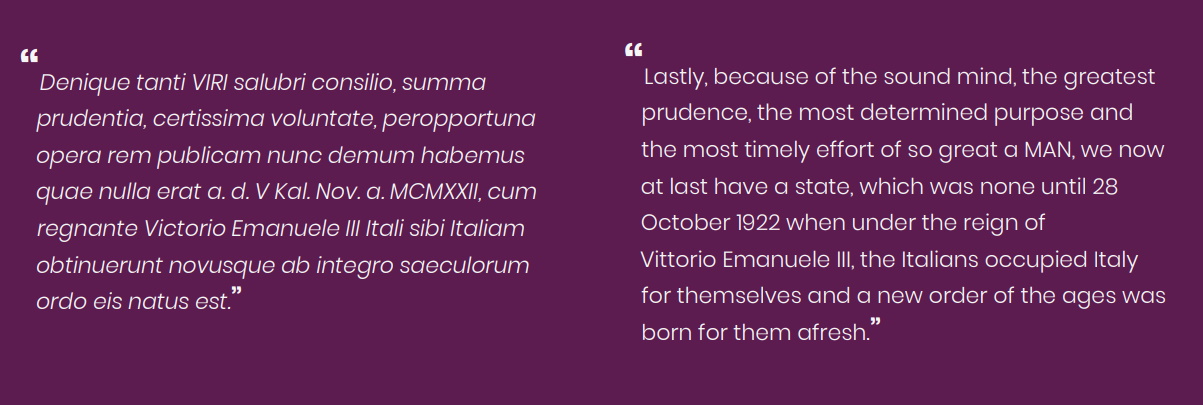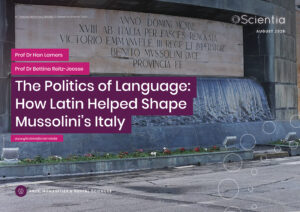Prof Han Lamers – Prof Dr Bettina Reitz-Joosse | The Politics of Language: How Latin Helped Shape Mussolini’s Italy
^ Fontana dell’impero, Brindisi. © Domenico Simone Tucci.
When wandering through Italian cities today, visitors will encounter Latin inscriptions on all manner of buildings and monuments. While many date back to ancient Rome, the Middle Ages, or the Renaissance, others were created during Benito Mussolini’s Fascist regime (1922–1943). These Latin texts weren’t merely decorative — they were deliberately crafted political tools that helped forge connections between Fascist Italy and ancient Rome, embedding the regime’s ideology into the very fabric of Italian society.
Ongoing research by Professor Han Lamers (University of Oslo) and Professor Bettina Reitz-Joosse (University of Groningen) reveals how Fascist Italy weaponized ancient Rome’s language to legitimise its power and connect Mussolini’s regime to Italy’s imperial past. Their projects involve collaboration with an international team of mostly junior researchers based in Norway, the Netherlands, Austria, and Italy.
The Hidden Power of an Ancient Language
Under the leadership of Benito Mussolini, Latin acquired distinct ideological significance. It became a potent visual and symbolic element in Fascist propaganda across diverse media — from postcards and medals to monumental architecture and even the Italian landscape itself.
Lamers and Reitz-Joosse’s research reveals how Latin served as more than just a written language, it became a visual sign of recognition that signified the vigilant presence of Mussolini’s regime. Even for Italians who couldn’t understand Latin, these inscriptions conveyed symbolic meaning through their physical presentation, location, and association with Fascist ideology.

Inscription at Piazza Adriana, Rome © A. Nastasi
Their work thus challenges the idea that Latin was confined to elite cultural circles. Even if most Italians couldn’t read Latin, the language continued to be part of their daily experience under Mussolini. From medals awarded to Fascist youth organizations to tapestries displayed during mass spectacles, Latin appeared in various contexts throughout Italian society. In 1923, Mussolini himself received a gold medal adorned with the fasces symbol and the Latin inscription ‘In hoc signo vinces’ (‘In this sign, you shall conquer’), echoing the Roman Emperor Constantine, who, before an important battle, reportedly saw similar words in a vision, accompanied by a cross. This was another effort to legitimize Mussolini’s personal power.
A Language of Legitimisation
Latin’s presence extended far beyond academic circles. Prof Lamers highlights how Latin inscriptions appeared across Italy, from major cities to small towns, and in various contexts, ranging from official state buildings to everyday objects, such as postcards and stamps.
One striking example is a postcard dated just two days after Mussolini’s March on Rome that brought him to power in 1922. The postcard features a portrait of Mussolini, images of Fascist symbols, and a Latin caption arranged to resemble an elegiac couplet — a classical poetic form. Though the Latin text contains linguistic peculiarities, its presence serves to elevate the political imagery with a sense of Roman gravitas, a strategy also used by extremist movements today, who often seek to associate themselves with the supposed ‘glory’ of societies from antiquity. The postcard example illustrates how Latin was used not just by the Fascist regime but also by private individuals to express political allegiance, showing how the language permeated multiple levels of society.

Inscription of Piazza di Sant’Andrea della Valle, Rome © A. Nastas
The ‘Speaking Stones’ of Fascism
Architectural inscriptions played a particularly important role in Fascist propaganda. Lamers and Reitz-Joosse have been working together with Dr Antonino Nastasi, an expert in modern Latin epigraphy, to study the Latin epigraphy of Fascist Rome and make it accessible.
Within the ongoing project in Oslo, Prof Lamers examined how Latin texts were incorporated into building façades to convey specific political messages, focusing on two ‘Case del Mutilato’ (‘Houses of the Wounded’) — buildings dedicated to wounded war veterans, which embodied the Fascist cult of patriotic sacrifice. Despite their different architectural styles (modernist in Pordenone and more traditionally Roman in Catania), both buildings feature prominent Latin inscriptions on their façades. In Pordenone, the inscription quotes Virgil’s Aeneid, while the Catanian building displays an original Latin composition praising the unwavering spirit of wounded veterans.
While the practice of inscribing buildings was not new, Fascism appropriated it as a tool of promoting Fascism and its leader. Inscriptions transformed buildings into ‘speaking stones’ that connected the modern Fascist state to ancient Rome. The physical features of the inscriptions, including lettering style, size, and placement, reinforced their political significance. In Pordenone, the modernist lettering with interpuncts (dots between words) recalled ancient Roman inscriptions while incorporating modernist shapes, visually linking ancient and Fascist Rome.

Casa del Mutilato in Pordenone. Photograph by L. Laureati. License CC-BY.
Latin Propaganda Built into the Landscape
Perhaps the most extraordinary example of Latin’s material presence in Fascist Italy was the ‘pineta Dux’ — a formation of approximately 20,000 pine trees planted on the western slope of Monte Giano (about 80 kilometres northeast of Rome) to spell out the Latin word ‘DVX’ (leader).
Created in the late 1930s by forestry students with assistance from the local population, this massive landscape inscription inscribed Mussolini’s authority onto the Italian countryside. The choice of pine trees wasn’t accidental; they evoked both classical Rome and contemporary nationalist symbolism, as pine trees had become part of efforts to create landscapes that cemented Italian national identity.
The pine tree formation served a practical purpose, protecting a nearby village from landslides, while simultaneously projecting Fascist power across the landscape. This remarkable example illustrates how Latin became part of the physical fabric of Italy under Fascism. Lamers intends to further investigate how the word DVX was used in Fascist Italy in a forthcoming paper.

The ‘pineta Dux’ in ca. 2017. Image from MeteoWeb
A Forgotten Literary Movement
Lamers and Reitz-Joosse’s collaborative research goes beyond physical inscriptions to explore a previously unstudied body of Latin literature with explicitly Fascist themes. Between 1922 and 1943, Italy produced a notable body of Latin literature celebrating Fascism, including lyric odes praising Mussolini, prose orations extolling the regime, and epic poems about Italy’s colonial exploits in Africa. Their article ‘Lingua Lictoria: The Latin Literature of Italian Fascism’, published in 2016, marked the first comprehensive examination of this subject. Lamers, Reitz-Joosse, and their team have since then created a digital library of over 120 Fascist Latin texts, and continue to discover new material through careful examination of library holdings and archives.
Who were the people writing Latin poetry and prose about Mussolini and Fascism? Lamers and Reitz-Joosse identified several groups who contributed to this mechanism of Fascist propaganda. University professors of classics, such as Nicola Festa (who translated some of Mussolini’s speeches into Latin), lent their scholarly expertise to the Fascist cause. However, the largest group consisted of high school Latin teachers, who wrote both educational texts for schools and more ambitious creative works. Several Catholic clerics, some of whom were also teachers, contributed Latin compositions as well. The motivations behind these compositions varied widely. Some authors were genuinely enthusiastic about Fascism, while others responded to professional encouragement or even pressure from the regime.

Excerpt from the Codex Fori Mussolini, authored by Aurelio Giuseppe Amatucci in 1932 and concealed beneath the obelisk at the Foro Italico in Rome (more on the following page).
Making Latin Modern – and Fascist
Latin might seem like an antiquated choice for a movement that presented itself as revolutionary and modernist, but Lamers and Reitz-Joosse emphasize that Fascist intellectuals worked hard to position the ancient language as ideally suited to modern life. Latin enthusiasts, such as Carlo Vignoli, argued that the language was entirely capable of expressing modern concepts. Vignoli highlighted Latin’s use in the field of aviation —an important symbol of modernity— citing Latin mottoes on aeroplanes and in airports, as well as Latin inscriptions on monuments and medals.
Beyond mere modernisation, Latin was increasingly presented as a distinctively Fascist language. Aurelio Giuseppe Amatucci, a classicist and school inspector, claimed that Latin composition should be a constitutive part of the ‘reevocation of the Roman world’ that he considered one of Fascism’s great achievements. For Amatucci, using Latin to express ‘new sentiments, new thoughts, and new plans’ was ‘an elevated sign of regained national spirit’.
Mussolini himself reinforced this connection, declaring that Latin was ‘the language of our times, of our very difficult but also very beautiful Fascist times’, and that it placed Italians ‘under a serious obligation, because it is the language of a people of soldiers, of conquerors, of builders, of legislators, of victors’. While Mussolini’s knowledge of Latin was limited, Prof Lamers’ research has shown that the leader of Fascism cultivated the image that he was familiar with the language, using it in his speeches and writings to express political ideas.


Medal celebrating the Battle for Grain. 40 mm. AE. © Nomisma.
Mussolini’s Time Capsule
One of the most fascinating documents researched by Lamers and Reitz-Joosse concerns a hidden Latin text meant to secure Fascism’s legacy for future generations. In 1932, as part of the celebrations marking the tenth anniversary of Fascist rule, Mussolini unveiled a massive white marble obelisk at Rome’s new sports complex, the Foro Mussolini (today’s Foro Italico). Unknown to the cheering crowds, a metal box had been sealed inside the base of this monument. The box contained gold coins and a Latin text written on parchment: the Codex Fori Mussolini. This document, composed by Amatucci, presented a carefully crafted narrative of the rise of Italian Fascism and its leader. The text was deliberately hidden away so that it might be discovered in the distant future, when it would convey the Fascists’ own vision of their achievements and place in history to generations yet unborn.
Lamers and Reitz-Joosse performed the first detailed study of this remarkable text, providing a critical translation and analysis of the Codex. Their work illuminates not only how Italian Fascism sought to control its future reception, but also reveals new insights into the role Roman antiquity played in Fascist ideology and propaganda. The original document was written by hand on parchment, in humanist script, and decorated with miniatures by Enrico Brignoli in the workshop of Nestore Leoni, a famous calligrapher. This physical form evoked the Middle Ages and Renaissance, periods of Italian cultural prominence that were also important to Fascist national identity, all of which Latin could evoke.
The researchers note a fascinating paradox in the Codex’s function. While the Codex affirms the eternity of the obelisk, the only way it could be read would be if the monument was torn down. At that point, only the Codex itself would still be able to, in its words, ‘immortalise for eternity the outstanding achievements of Fascism’.
The Ethics of Publishing a Fascist Text Today
The research team faced an ethical dilemma in publishing the Codex and similar texts. Would they be helping its Fascist creators achieve exactly the kind of reception they craved? Lamers and Reitz-Joosse grappled with this concern, seeing it as important to put the Codex and similar propaganda texts in their proper contexts. By analysing the Fascist hijacking of Latin, they aim to contribute to an informed and critical reception of this text and other documents like it.
Lamers and Reitz-Joosse, together with their team, have been curating a volume featuring a selection of Latin texts from Fascist Italy and National Socialist Germany, complete with English translations and annotations. They anticipate that this collection, titled Texts of Tyranny, will be made available in Open Access later this year or early next year. Co-edited by Dr Katharina-Maria Schön, the volume seeks to raise awareness of this difficult textual heritage, also beyond academic circles.
Understanding the Power of Language Propaganda
Through detailed analysis of these texts and their cultural contexts, Lamers and Reitz-Joosse have contributed to our understanding of the cultural politics of Fascism. Their work represents an important step toward understanding the complex role of Latin in political material culture, opening up further questions about how the language was received by different groups within Italian society, and how it compared to the use of ancient and historical languages by other political movements worldwide.
SHARE
DOWNLOAD E-BOOK
REFERENCE
https://doi.org/10.33548/SCIENTIA1289
MEET THE RESEARCHER

Prof Dr Han Lamers
The Norwegian Institute in Rome (Italy) and the Department of Philosophy, Classics, and the History of Art and Ideas, University of Oslo (Norway)
Prof Lamers studied Classics and Art History at Leiden University and the University of Leuven, earning his PhD from Leiden University in 2013. He is Full Professor of Classics at the University of Oslo and serves as Director of the Norwegian Institute in Rome. Much of his research is centred on the cultural history of Ancient Greek and Latin after antiquity. He has broken new ground in the study of Ancient Greek in early modern Europe, as well as in the political appropriation of Latin under Italian Fascism and National Socialism. Among his publications are Greece Reinvented: Transformations of Byzantine Hellenism in Renaissance Italy (2015), The Codex Fori Mussolini: A Latin Text of Italian Fascism (2016), and The Latin Poems of Manilius Cabacius Rallus of Sparta (2024).
His work has been recognized with several awards including the Van Woudenberg Dissertation Prize. Since 2022, he has been one of the Principal Investigators of ‘Greek Heritage in European Culture and Identity’, which is funded by the European Union (HORIZON-WIDERA-2021-ACCESS-03-01-Twinning Call; project number 101079379). He is also the Co-Editor of Symbolae Osloenses: Norwegian Journal of Greek and Latin Studies (Taylor & Francis).
CONTACT
E: han.lamers@roma.uio.no
W: https://www.hf.uio.no/ifikk/english/people/aca/classics/tenured/hanla/

Prof Dr Bettina Reitz-Joosse
Aletta Jacobs Professor of Latin Literature and Culture, Faculty of Arts, University of Groningen (the Netherlands)
Prof Reitz-Joosse studied Classics at Corpus Christi College, Oxford, and obtained her PhD from Leiden University in 2013. From 2018 to 2023, she served as a member of De Jonge Akademie of the Dutch Royal Academy of Arts and Sciences. She is the future director of OIKOS, the Dutch national graduate school for the study of the ancient world. Much of her research focusses on the relationship between literature and material culture in the Roman world. In 2021, her monograph, Building in Words: The Process of Construction in Latin Literature, was published by Oxford University Press.
Since 2023, she has been the PI of the project FACERE, which examines Roman attitudes towards processes of manual creation and is funded through an ERC Starting Grant. She has also broken new ground in the study of the appropriation of Latin by Fascist Italy and National Socialist Germany in the 20th Century, funded through the Anchoring Innovation project. She teaches in BA and MA programmes at the University of Groningen and was elected Lecturer of the Year of the University in 2018. In 2024, she was appointed to the Aletta Jacobs Chair of Latin Literature and Culture in recognition of her work.
CONTACT
W: https://www.rug.nl/staff/b.l.reitz-joosse/cv
FUNDING
The research project New Signs of Antiquity is financed by the Research Council of Norway (project number 316016). Additionally, Fascist Latin Texts (FLT) is supported by the Faculty of Humanities at the University of Oslo.
Anchoring Innovation is the Gravitation Grant research agenda of the Dutch National Research School in Classical Studies, OIKOS. It is financially supported by the Dutch ministry of Education, Culture and Science (NWO project number 024.003.012). For more information about the research program and its results, see the website www.anchoringinnovation.nl
KEY COLLABORATORS
Nicolò Bettegazzi
Hylke de Boer
Alessio Casalini
Allegra Costantini
Paola D’Andrea
Lorenzo Di Simone
Beatrice Maria Chiara Filetti
Marta Francesca Forlano
Erlend Østrem Myklebust
Antonino Nastasi
Bil Johan Simon Olsson
Camillo Carlo Pellizzari di San Girolamo
Katharina-Maria Schön
Wolfgang Strobl
Vincenzo Torchia
Marcello Zeni
Tor Ivar Østmoe
COLLABORATION PARTNERS
Brepols’ Centre ‘Traditio Litterarum Occidentalium’ (CTLO)
CLARIAH-VL: Open Humanities Service Infrastructure
Humit – Centre for Digital Development
FURTHER READING
N Bettegazzi, Ideologies of Latin in Fascist Italy (1922–1943): The Language of Rome between Fascism and Catholicism, PhD thesis, University of Groningen, 2023. DOI: 10.33612/diss.609906966.
H Lamers, Language on Display: Latin in the Material Culture of Fascist Italy, Journal of Latin Cosmpolitanism and European Literature 8 (2023): 69–101. DOI: 10.21825/jolcel.84801
H Lamers, Mussolini’s Latin, Symbolae Osloenses: Norwegian Journal of Greek and Latin Studies 96 (2022): 205–29. DOI: 10.1080/00397679.2023.2173393
H Lamers & B Reitz-Joosse, The Codex Fori Mussolini: A Latin Text of Italian Fascism, Bloomsbury Academic, 2016. DOI:
H Lamers & B Reitz-Joosse, Lingua Lictoria: The Latin Literature of Italian Fascism, Classical Receptions Journal 8, no. 2 (2016): 216–52. DOI: 10.1093/crj/clv001.
H Lamers & B Reitz-Joosse, Spectacular Latin: The Role of the Latin Language in Political Spectacles under Italian Fascism, Fascism: Journal of Comparative Fascist Studies 12 (2023): 279–305. DOI: 10.1163/22116257-bja10062
H Lamers & B Reitz-Joosse (eds), Fascist Latin Texts [an online corpus of Latin texts from Fascist Italy], University of Oslo, 2025. URL: https://flt.hf.uio.no
H Lamers & E Østrem Myklebust, Mussolini’s Medals: Latin – Materiality – Politics, Peeters, 2025.




REPUBLISH OUR ARTICLES
We encourage all formats of sharing and republishing of our articles. Whether you want to host on your website, publication or blog, we welcome this. Find out more
Creative Commons Licence (CC BY 4.0)
This work is licensed under a Creative Commons Attribution 4.0 International License. 
What does this mean?
Share: You can copy and redistribute the material in any medium or format
Adapt: You can change, and build upon the material for any purpose, even commercially.
Credit: You must give appropriate credit, provide a link to the license, and indicate if changes were made.
SUBSCRIBE NOW
Follow Us
MORE ARTICLES YOU MAY LIKE
Dr JoLee Sasakamoose – Dr Mamata Pandey | Empowering Indigenous Health: The Indigenous Wellness Research Collaborative in Saskatchewan
The Indigenous Wellness Research Collaborative is a transformative alliance dedicated to advancing health systems and service delivery for Indigenous communities across Saskatchewan. Founded a decade ago and co-led by Dr Mamata Pandey, a research scientist at the Saskatchewan Health Authority, and Dr JoLee Sasakamoose (M’Chigeeng First Nation), Canadian Institute of Health Research Chair in Indigenous Wellness and Health Equity at the University of Regina, their team’s work is rooted in a commitment to Indigenous leadership and community-defined wellness goals. Guided by the Cultural Responsiveness Framework, the Collaborative prioritises creating ethical spaces that serve as a middle ground for respect, reciprocity, and authentic partnerships. The team employs a strengths-based approach to health research, centering Indigenous methodologies that respect the interconnectedness of spiritual, mental, emotional, and physical well-being.
Dr Richard Davies: The Forgotten Pioneer of Blood Research and University Reform
Dr Richard Davies was an 18th century physician whose bold ideas spanned medical science, public health, and university reform. Yet, his name is little known today. From discovering features of inflammation in blood, to proposing a national system to control cattle plague, his work prefigured modern approaches to medicine and governance. Nevertheless, his calls for change often fell on deaf ears, and his contributions were overlooked or appropriated by others. Dr Margaret DeLacy revisited Dr Davies’ remarkable career, exploring how a forgotten doctor helped shape the future of medical thinking.
How Food Environments Shape Our Eating Habits
How we eat dramatically impacts our health, yet millions of Americans live in ‘food deserts’ – areas with limited access to fresh, nutritious food. Recent research reveals that solving this crisis requires looking beyond just physical access to food to understand how our entire community environment shapes our dietary choices. Through a series of pioneering studies, Dr Terrence Thomas and colleagues at North Carolina A&T State University have been investigating how different aspects of our food environment influence what we put on our plates. Their findings suggest that creating lasting change requires reimagining how communities engage with food at every level.
Rediscovering Alfred Russel Wallace: The True Location of His Ternate Residence
In February of 1858, naturalist and explorer Alfred Russel Wallace, whilst in the village of Dodinga at Halmahera Island, Indonesia, independently outlined his theory of evolution through natural selection.
Wallace then returned to his rented home on the small island of Ternate, and sent his manuscript —now known as “The Ternate Letter”— to Charles Darwin.
For nearly 80 years Wallace’s rented house has been a subject of debate, with two houses contending as candidates albeit, as this paper confirms, neither being valid. The paper written by Paul Whincup describes how a combination of new research, fieldwork, and local insight has finally pinpointed the true site of Wallace’s House at Ternate.





